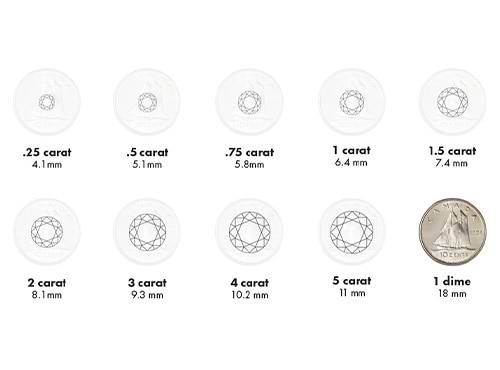The 4 C’s: Carat
Understanding the 4 C’s will help you find the perfect diamond for your partner
Diamond Carats
A carat is the unit of measurement used for the physical weight of diamonds.
One carat is equal to 200 milligrams or 1/5 of a gram. Once the weight in milligrams is determined, the diamond is subdivided into 100 points. This ensures an ultra precise measurement to the hundredth decimal place. Typical diamond weights range from 0.25 carats to 5 carats.
Carats are one of the most objective measurements of the 4 Cs for determining the value of a diamond. It directly corresponds to the weight of a diamond, while other Cs are more subjective.
Fun fact: the name ‘carat’ derives from carob, the popular chocolate substitute. Carob seeds were the standard measurement tool for diamonds up until the 20th century. Their small size and consistent shape made them an effective counterweight for diamonds.
Carats & Diamond Size
It’s important to remember that carats only determine the weight of a diamond, not its size. Shape, weight distribution, and cut quality also impact a diamond’s size. This means that two diamonds of the same carat weight can have different sizes.
Another vital thing to keep in mind is that a high carat doesn’t necessarily equate to a better diamond. A diamond with a small carat and high quality cut will be more brilliant and beautiful than a diamond with a large carat and poor quality cut. Most loose diamonds available for sale are one carat or less. The average engagement ring is also less than a carat.
Still, high quality diamonds with a high carat are very valuable. High quality gems are harder to find in large quantities of rough, which means a single two carat diamond will cost more than two one carat diamonds of the same quality. Up to two thirds of the total carat weight can be lost when raw diamonds are cut and polished into finished diamonds.
Carats & Diamond Appearance
Although we are often taught that bigger is better, this is not always the case with diamonds. Jewelers recommend paying more attention to the surface area of a diamond than its carat size, since it’s the more visible characteristic.
A diamond will increase in weight more than it increases in surface area. For example, a 0.50 carat diamond has a surface area of 5.1mm, while a one carat diamond has a surface area of 6.5mm. That’s only a 27% increase in surface area, despite having double the weight.
Additionally, differences in carat sizes can appear very minimal to the untrained eye. A 0.25 carat diamond will be noticeably smaller than a 2 carat diamond, but the difference in size between a 0.90 carat and a 1 carat diamond will not be substantial.
Carat & The Other Cs
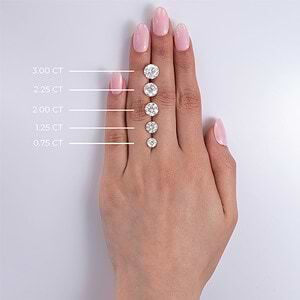
Round
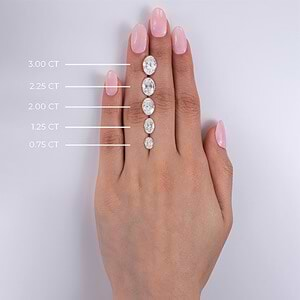
Oval
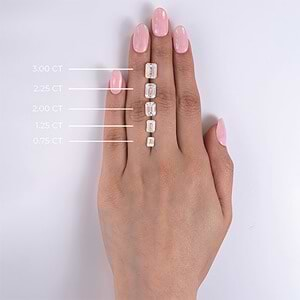
Emerald
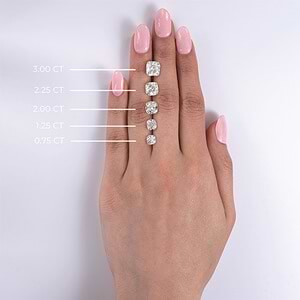
Cushion
Carat & The Other Cs
Some diamonds are cut with an emphasis on carat size, but they often sacrifice sparkle and symmetry. Pay attention to the cut as well as carat to ensure you get a beautiful diamond in the size you want.
Note that the larger a diamond is, the more inclusions will be noticeable. Cut should always be a high priority, but you’ll also want to pay attention to clarity grades with a larger stone.
- 0.25 - 0.50 carat diamonds. These weights hide inclusions well, so you can choose lower clarity grades and put a higher emphasis on cut and color. Look for a diamond with a Very Good or Ideal cut grade.
- 0.75 carat diamonds. This weight still hides inclusions, but they will start to become more apparent. Choose a clarity grade of SI1 or SI2 and a cut grade of Very Good or Ideal.
- 1 carat diamonds. Inclusions will become more apparent, but cut should still be your priority. Look for a stone with an Ideal or Excellent cut. If you’re choosing a design with a halo or side stones, put a higher emphasis on color and clarity grades.
- 1.25 - 1.5 carat diamonds. Prioritize cut and clarity. Look for stones with a clarity grade of VS2 or higher.
- 2 carat, 3 carat & 4 carat diamonds. Look for eye clean stones with a VS1 clarity grade or higher.
- 5 carat. Everything will be on display with a diamond this heavy. Look for one with Excellent cut, symmetry, and polish.
Carat Vs Karat
A carat should not be confused with a karat, the term given for determining gold purity in jewelry. British visitors and expats may have a tougher time distinguishing the two since carat is used for both diamond weight and gold content in the UK.
Both terms are relevant to diamond ring shopping, since the piece will have carats and karats. For example, a 1ct diamond ring in 14K gold means that the ring’s diamond weighs 1 carat, and is set in 14K gold.
Determining Carat In Lab Grown Diamonds
Lab grown diamonds can reach large carat weights, just like mined diamonds. Some lab grown diamonds have even weighed a whopping 15 carats!
Many shoppers love choosing lab grown diamonds to get more value for their money. Lab grown diamonds are more accessibly priced than mined diamonds, which means shoppers can comfortably choose larger carat weights.
Although size and weight definitely play important roles in a diamond’s appearance, remember that a high carat should not be the determining factor when choosing a diamond. Look for a diamond with a carat weight that complements its cut, clarity, and color and not the other way around.
More FAQs about Lab Grown Diamonds